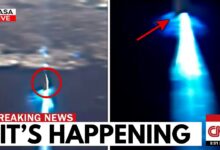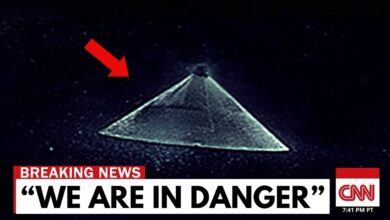Voyager 1’s Impossible Encounter in Deep Space CONFIRMS what WE ALL FEARED
**Voyager 1 – An Unexpected Encounter in the Heart of the Infinite Universe**

In the vastness of space, where light takes decades to penetrate, a lone traveler is wandering. It is **Voyager 1** – a small ship, only the size of a family car, but carrying the giant dream of mankind: to explore the universe.
Launched from Earth in 1977, Voyager 1 was originally designed to operate for only 5 years – enough time for it to fly by and record images of the giant planets in the Solar System. But then, nearly half a century has passed. Not only has it survived, it has gone further than any scientist could have imagined. Today, Voyager 1 is more than **14.5 billion miles** from Earth – so far that, if you were to send a radio signal to it, it would take more than 22 hours for the signal to reach it.
But the strange – and terrifying – things were just beginning.
Recently, NASA scientists began receiving inexplicable signals from Voyager. They were unlike any data they had ever seen: irregular bursts of electrical pulses, intermittent radio signals, interspersed with code that looked like messages… but did not match any format ever created by humans.
At first, it was thought to be a hardware failure – perhaps a faulty memory, or a misaligned antenna. But after a series of analyses and cross-checks, a more frightening hypothesis began to form: **Has Voyager encountered something?** Something that is not of our world. Or, scarier still… “it” has come to Voyager.
We used to think of space as a dead zone – impersonal, soundless, invisible. But to Voyager, it seemed that it was not empty at all. Something was listening. Something was looking back.
Voyager’s journey did not begin by accident. It was born from a rare opportunity—a perfect alignment of planets that occurs only once every 176 years. That opportunity opened the door for humanity to step outside the Solar System for the first time… and, perhaps, to an unnamed fear.
But none of these explanations could explain the uncanny precision of these oscillations, and even less why they lasted for months. How could such tightly structured “signals” appear in the supposedly lifeless interstellar space? Could these be the first whispers of an entity we have never encountered, something that exists in the vast night between the stars? And what was most surprising: it seemed *that* was turning its attention to the little machine called Voyager.
**The mystery of temperature fluctuations**
In early 2024, the mystery surrounding Voyager 1 deepened when temperature sensors – designed only to monitor the system during its approach to planets – began recording inexplicable values. These sensors, which had lain dormant for decades at temperatures of nearly 3 degrees above absolute zero, suddenly began to show regular temperature spikes: every 4.8 hours, the outer sensor array warmed up by nearly 30 degrees, then slowly cooled down again.
The cycle repeated with astonishing precision, which could only be explained by an external energy source. Even more remarkable, these temperature spikes and drops matched exactly the plasma pulses that Voyager had detected a few months earlier. Clearly, whatever Voyager encountered was not affecting a single instrument, but was “communicating” with several different systems simultaneously.
NASA engineers had eliminated every possibility of an internal error: it was not residual thermal fluctuations from the atomic machinery, nor was it a flickering circuit that was creating cross-feedback between instruments. In the end, only one conclusion remained – Voyager was *really* sensing an external, rotating energy source, with a regular and deliberate cycle.
This temperature rise and fall posed a major risk: sudden “heating up” could break many systems that had already exceeded their design life. If the sensors were overstretched, Voyager would likely lose the ability to transmit data. But another paradox emerged: despite the adverse thermal cycle, Voyager’s energy efficiency increased strangely – as if “something” was optimizing it, compensating for the thermal stress.
**Mysterious deviation**
After 47 years of following a trajectory that we could calculate with great precision, in mid-2024, Voyager 1 suddenly began to deviate from its predicted course. The first time, it was only a few kilometers – still within acceptable error. But over the next few months, the deviations continued to increase; by early 2025, the gap between the actual and “planned” positions had grown to hundreds of kilometers, and the fluctuations were becoming more pronounced.
But the strangest thing was not the extent of the deviations, but the way Voyager adjusted its course: tiny, seemingly intentional adjustments, like a sailboat going against the wind, changing the angle of its sails minute by minute. While the navigational control system was programmed to keep its antenna pointed at Earth, Voyager had neither the fuel nor the code to do so.
Engineers sent out commands in the opposite direction, hoping to “pull” Voyager back on track. Although the receiver reported successful execution, Voyager’s trajectory continued to drift—as if NASA’s controls had been overridden by an *outside* force.
**A Glance from the Dark**
In a bold move, NASA reactivated the camera system that had been turned off since 1990. Twenty-one hours later—the time it took for the signal to travel back—a thrilling message came back: not an image of a planet or celestial body, but a visualization of the plasma wave data that Voyager had collected. An intricate spiral pattern, loop after loop, like a giant fingerprint or the concentric rings in the trunk of an ancient tree.
In fact, it wasn’t a photograph, but the *product* of data processing—something Voyager’s meager 68KB computer couldn’t do on its own. Then, one by one, the systems that had been shut down came back to life: infrared, ultraviolet, aurora detectors… All came back to life, sending back “compressed” and “optimized” data packets—something Voyager’s old hardware couldn’t do.
With each packet, Voyager seemed to “respond” before NASA had even given the command. Engineers tried keeping the command on the computer isolated, not transmitting it, and nothing happened. Voyager was silent. It only “acted” when the actual command was broadcast over the radio waves.
**A message from space**
By mid-2025, scientists realized that the information Voyager was sending back contained not just raw numbers but also sophisticated “hidden layers”: a three-dimensional grid describing the surrounding space, spiral mathematics inspired by the golden ratio but adjusted for the hydrogen–helium ratio in the universe, and finally a collection of pulse data from pulsars, drawing a “map” to a blank spot 4.3 light years away.
All signs point to one thing: Voyager 1 is not just passively collecting data, but seems to be communicating with a distant intelligence. A subtle, multi-layered message pointing the way to an invisible giant in the void.
And perhaps we have missed our first contact with an extraterrestrial “entity”… without even knowing it.








